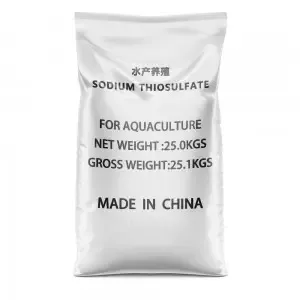



sodium bisulfate lower alkalinity
Understanding Sodium Bisulfate and Its Role in Lowering Alkalinity
Sodium bisulfate, often referred to as sodium hydrogen sulfate, is a chemical compound with the formula NaHSO₄. It is widely utilized in various industrial and domestic applications, most notably for its role in lowering alkalinity in different water systems. Understanding its properties, uses, and the chemistry behind its function is crucial, especially in fields such as water treatment, swimming pool maintenance, and food processing.
Chemical Properties of Sodium Bisulfate
Sodium bisulfate is a white crystalline powder that is highly soluble in water. Upon dissolution, it dissociates into sodium ions (Na⁺) and bisulfate ions (HSO₄⁻). The presence of bisulfate ions imparts acidic properties; thus, sodium bisulfate can effectively act as a pH decreaser. The compound is also hygroscopic, meaning it can absorb moisture from the air, which is an important consideration in its storage and handling.
The Importance of Controlling Alkalinity
Alkalinity refers to the capacity of water to neutralize acids, a crucial factor in various applications ranging from pool maintenance to industrial processes. High alkalinity levels can lead to several problems, including scaling, poor chlorine efficiency in swimming pools, and interference with certain analytical processes in laboratories. Lowering alkalinity to optimal levels ensures better control over pH and improves overall water quality.
How Sodium Bisulfate Lowers Alkalinity
When sodium bisulfate is added to water with high alkalinity, it reacts with free hydroxide ions (OH⁻) present in the solution. The bisulfate ions donate protons (H⁺) to these hydroxide ions, effectively neutralizing them and forming water and sulfate ions. This reaction decreases the concentration of hydroxide ions in the solution, leading to a lower pH and reduced alkalinity.
An additional benefit of using sodium bisulfate is its fast-acting nature. Unlike other acids, such as hydrochloric or sulfuric acid, which can introduce other complicating factors, sodium bisulfate primarily dissociates into bisulfate ions, making it a preferred choice for quick adjustments in alkalinity without significantly altering the other aspects of water chemistry.
sodium bisulfate lower alkalinity

Applications of Sodium Bisulfate in Lowering Alkalinity
1. Swimming Pools In swimming pool maintenance, the ideal alkalinity range is typically between 80-120 ppm (parts per million). High alkalinity can hinder chlorine effectiveness and lead to cloudy water. By adding sodium bisulfate, pool operators can efficiently lower alkalinity levels, thereby ensuring a safer and cleaner swimming environment.
2. Industrial Processes Many industries, including textile and paper manufacturing, require precise pH control for optimal production. Sodium bisulfate is often employed to neutralize excessively alkaline wastewater, which is essential before discharge into municipal treatment systems.
3. Food Processing In food production and processing, maintaining the right acidity levels is vital for product taste and safety. Sodium bisulfate can be used to adjust pH levels in various food products, ensuring they adhere to safety standards while achieving desired flavors.
4. Laboratories Many analytical procedures require specific pH levels for accurate measurements. Sodium bisulfate serves as an effective pH adjuster in laboratories, allowing for a controlled environment necessary for reliable results.
Environmental Considerations
While sodium bisulfate is a useful tool in managing alkalinity, it is essential to handle it with care and consider its environmental impact. Although it is less corrosive than stronger acids, any chemical added to water systems should be used judiciously to prevent adverse effects on aquatic life. It is recommended to follow the guidance of water quality experts and adhere to local regulations regarding chemical usage in water treatment.
Conclusion
Sodium bisulfate is a versatile compound that plays a significant role in lowering alkalinity across various applications. Its ability to quickly and effectively neutralize excess alkalinity makes it an invaluable asset in settings ranging from swimming pools to industrial processes. By understanding and utilizing this compound responsibly, one can ensure better water quality and enhance the functionality of numerous systems that rely on precise pH levels.
-
Why Sodium Persulfate Is Everywhere NowNewsJul.07,2025
-
Why Polyacrylamide Is in High DemandNewsJul.07,2025
-
Understanding Paint Chemicals and Their ApplicationsNewsJul.07,2025
-
Smart Use Of Mining ChemicalsNewsJul.07,2025
-
Practical Uses of Potassium MonopersulfateNewsJul.07,2025
-
Agrochemicals In Real FarmingNewsJul.07,2025
-
Sodium Chlorite Hot UsesNewsJul.01,2025










